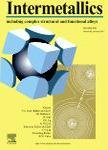版权所有:内蒙古大学图书馆 技术提供:维普资讯• 智图
内蒙古自治区呼和浩特市赛罕区大学西街235号 邮编: 010021

作者机构:Harbin Inst Technol Sch Mat Sci & Engn Harbin 150001 Peoples R China Minist Educ Harbin Inst Technol Key Lab Microsyst & Microstruct Mfg Beijing Peoples R China Harbin Inst Technol Dept Astronaut & Mech Harbin 150001 Peoples R China Univ Birmingham Sch Met & Mat Edgbaston B15 2TT England Univ Auckland Dept Chem & Mat Engn Auckland New Zealand
出 版 物:《INTERMETALLICS》 (金属间化合物)
年 卷 期:2010年第18卷第5期
页 面:1056-1061页
核心收录:
学科分类:0806[工学-冶金工程] 08[工学] 0805[工学-材料科学与工程(可授工学、理学学位)] 0703[理学-化学]
基 金:National Natural Science Foundation of China (NSFC) [50904021, 50771040, 10732010] Hi-Tech Research and Development Program of China [2007AA03Z518] Foundation of China Postdoctor University of Auckland, New Zealand [9217/3609144]
主 题:Glasses metallic Plastic deformation mechanisms Mechanical properties at ambient temperature Electron microscopy scanning Mechanical testing
摘 要:Nanoscratch experiments on four bulk metallic glasses using a pyramidal diamond tip (Berkovich) indenter have been carried out under different loads and scratching velocities. There exists a general correlation between the hardness and wear resistance, i.e., a lower hardness produces a lower wear resistance. Scratch velocity appears to have little effect on the scratch depths of the four alloys studied. However, faster scratch velocity leads to finer shear bands. Compared with ribbon sample with the same chemical composition, Ti-based bulk glassy sample that experienced slower cooling rate during solidification, and thus contained less free volume, exhibits better wear resistance. (C) 2010 Elsevier Ltd. All rights reserved.